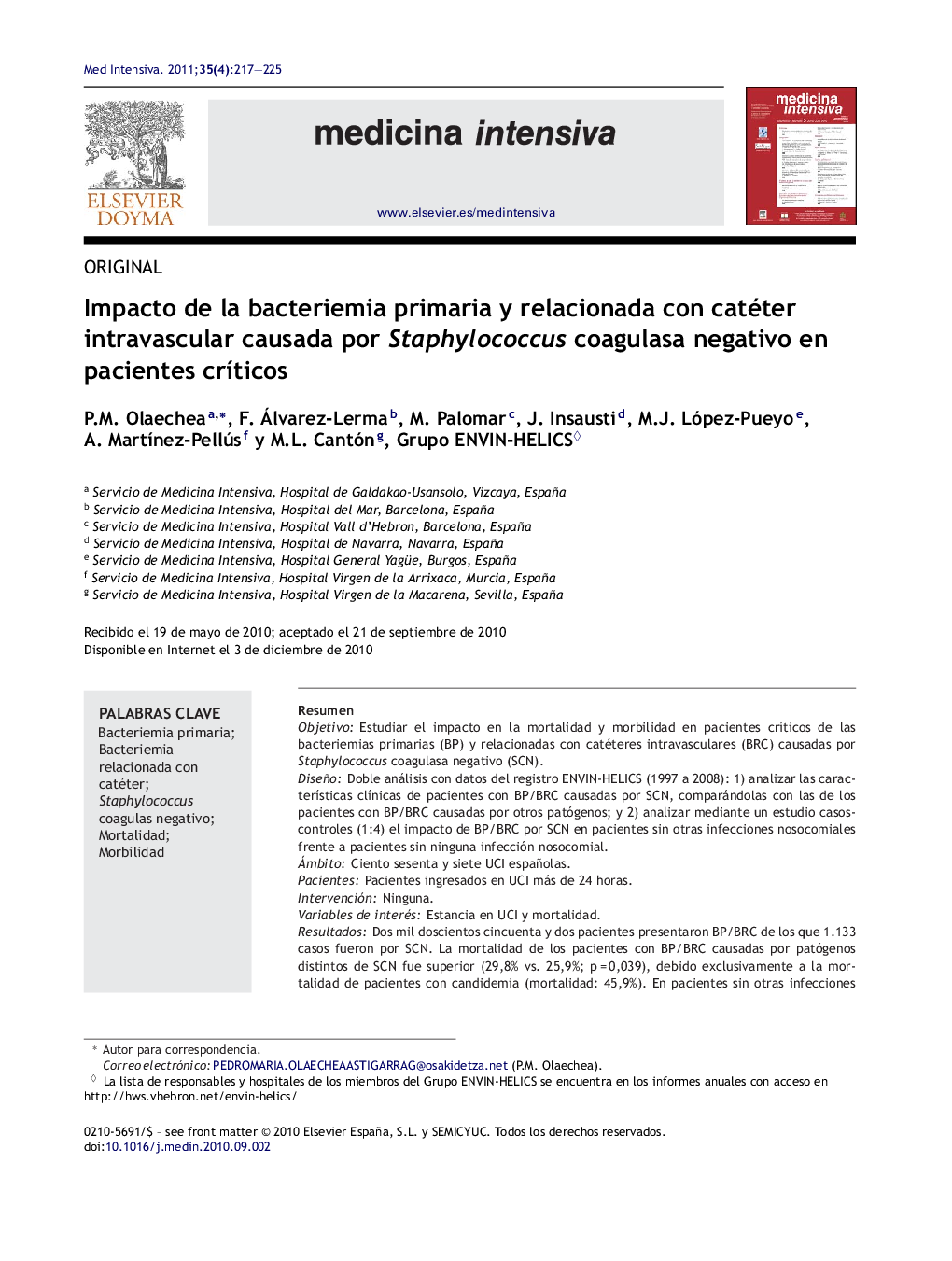| Article ID | Journal | Published Year | Pages | File Type |
|---|---|---|---|---|
| 3113327 | Medicina Intensiva | 2011 | 9 Pages |
ResumenObjetivoEstudiar el impacto en la mortalidad y morbilidad en pacientes críticos de las bacteriemias primarias (BP) y relacionadas con catéteres intravasculares (BRC) causadas por Staphylococcus coagulasa negativo (SCN).DiseñoDoble análisis con datos del registro ENVIN-HELICS (1997 a 2008): 1) analizar las características clínicas de pacientes con BP/BRC causadas por SCN, comparándolas con las de los pacientes con BP/BRC causadas por otros patógenos; y 2) analizar mediante un estudio casos-controles (1:4) el impacto de BP/BRC por SCN en pacientes sin otras infecciones nosocomiales frente a pacientes sin ninguna infección nosocomial.ÁmbitoCiento sesenta y siete UCI españolas.PacientesPacientes ingresados en UCI más de 24 horas.IntervenciónNinguna.Variables de interésEstancia en UCI y mortalidad.ResultadosDos mil doscientos cincuenta y dos pacientes presentaron BP/BRC de los que 1.133 casos fueron por SCN. La mortalidad de los pacientes con BP/BRC causadas por patógenos distintos de SCN fue superior (29,8% vs. 25,9%; p = 0,039), debido exclusivamente a la mortalidad de pacientes con candidemia (mortalidad: 45,9%). En pacientes sin otras infecciones nosocomiales, la BP/BRC por SCN (414 pacientes) es un factor independiente de riesgo de tener una estancia superior a la media (OR 5,81; IC 95%: 4,31-7,82; p < 0,001).ConclusiónLa mortalidad cruda de los pacientes que padecieron BP/BRC causada por SCN es similar a la de los pacientes con BP/BRC causada por otras bacterias, pero inferior a la de los pacientes con candidemia. Comparándolo con la estancia en UCI de pacientes sin infecciones nosocomiales, la BP/BRC por SCN es un factor apreciable de prolongación de estancia.
ObjectiveTo study the impact of coagulase-negative staphylococcal (CNS) primary and intravascular catheter-related bloodstream infection (PBSI/CRBSI) on mortality and morbidity in critically-ill patients.DesignWe performed a double analysis using data from the ENVIN-HELICS registry data (years 1997 to 2008): 1) We studied the clinical characteristics and outcomes of patients with CNS-induced PBSI/CRBSI and compared them with those of patients with PBSI/CRBSI caused by other pathogens; and 2) We analyzed the impact of CNS-induced PBSI/CRBSI using a case-control design (1:4) in patients without other nosocomial infections.Setting167 Spanish Intensive Care Units.PatientsPatients admitted to ICU for more than 24 hours.Results2,252 patients developed PBSI/CRBSI, of which 1,133 were caused by CNS. The associated mortality for PBSI/CRBSI caused by non-CNS pathogens was higher than that of the CNS group (29.8% vs. 25.9%; P = .039) due exclusively to the mortality of patients with candidemia (mortality: 45.9%). In patients without other infections, PBSI/CRBSI caused by CNS (414 patients) is an independent risk factor for a higher than average length of ICU stay (OR: 5.81, 95% CI: 4.31-7.82; P < .001).ConclusionCrude mortality of patients with CNS-induced BPSI/CRBSI is similar to that of patients with BPSI/CRBSI caused by other bacteria, but lower than that of patients with candidemia. Compared to patients without nosocomial infections, CNS-induced PBSI/CRBSI is associated with a significant increase in length of ICU stay
